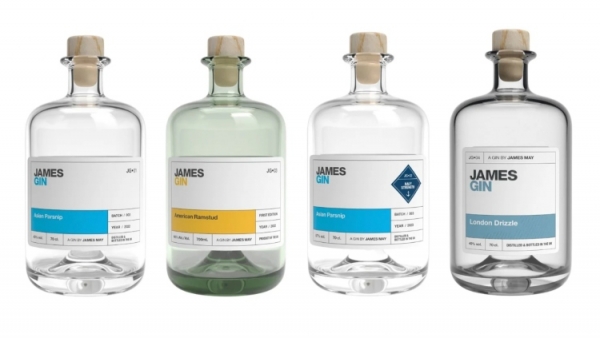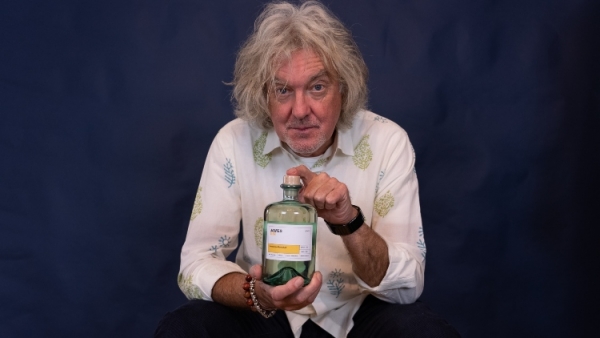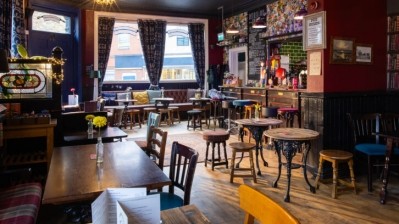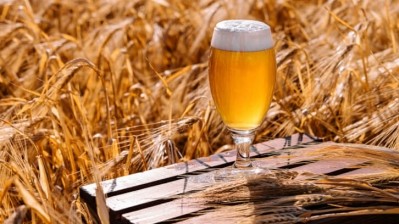BIG INTERVIEW
THE BIG INTERVIEW: James May is in the driving seat for beer and gin
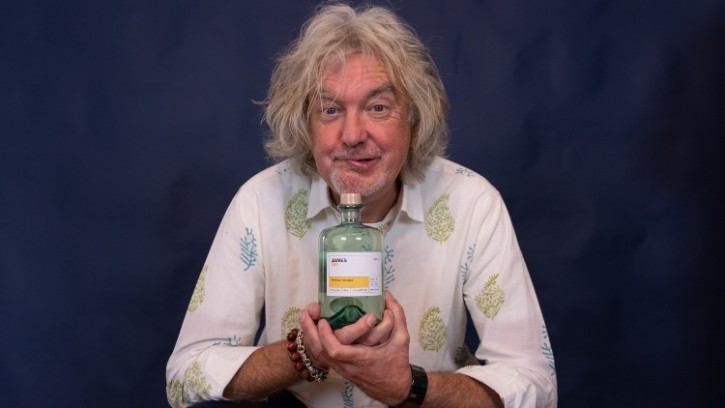
And he was also in a few BBC TV series alongside wine buff Oz Clarke in which beer-loving May learns about wine abroad and then the duo toured Britain looking at the gamut of alcoholic drinks available.
The Morning Advertiser’s associate features editor Gary Lloyd caught up with May, who had been forced to sit in his car to talk while noisy works took place at a nearby house, pausing only to accept a cup of tea during the chat.
May is the co-owner of freehouse the Royal Oak in the south Wiltshire village of Swallowcliffe and is also the co-owner of gin brand James Gin.
So how did the Bristol-born Top Gear presenter come to be the co-owner of a village pub?
“I’d love to pretend it was a massive act of philanthropy on behalf of the community but I think it was probably fairly selfish because it’s the only pub within walking distance of our little cottage that we’ve got in the neighbouring village,” he begins.
“It’s less than a mile away and it was threatened with closure because the previous owners had had enough of it. And I thought, well, if that pub is turned into a house or a supermarket or something, there won’t be a pub for me to go to without using the car, which would just be terrible.
“So what I effectively did was I just bought myself a very expensive round with another bloke!
“I’m an excellent businessman, as you can imagine. I did the deal just before Covid started so we bought it and then immediately had to shut it. It was fairly trying for a few years and we had to dribble a bit of money into it but it now sustains itself quite well.”
He adds the site doesn’t require any further investment from the guys at the top currently but it doesn’t make a profit and, having never taken any money from it, he says the pub “wipes its own face”.
Being a beer man, his local in west London is a Fuller’s pub and is a fan of London Pride and Frontier lager.
He’ll even go to the extent of buying a beer and bringing it home to drink so he’s “got a beer at my desk while I’m pretending to work”.
When he visits other pubs, he will try different bitters just for curiosity’s sake and not necessarily for the fact those drinks are local.
“I’ll try bitters, pale ales, anything like that, and on hot days and occasions, sometimes at home when I’m cooking or if I go to, say, an Indian restaurant, which I do quite a bit, I will often drink a lager because I think the coldness and slight fizziness goes well with spicy food.
“Lager is a beer you can have with food but I’ve always thought of ales, bitters and so on as beers you drink for the pure pleasure of drinking beer and not an accompaniment to food. Saying that I will drink wine for the pleasure of drinking wine while the French tend to frown on that a bit and they think wine is something you have while you’re eating… then again, they can make a lunch last for four hours!”
On the suggestion that wine is taxed at a very low rate in France, May explains: “I know agricultural workers in France, especially historically – and I suppose this is a little bit like when we had ‘small beer’ in England at the time when the water wasn’t dependable – would take it a small barrel of wine into the fields to drink during the day while they did their harvesting or ploughing or whatever it is.
“It’s a huge amount of wine and you think, well, the French must be totally pissed while they’re doing their farming, but actually it’s below vin de table strength so it’s quite weak at about 8% or 9% I think. But if you drink four or five pints of it, you’re still going to be a bit bladdered!”
Sticking on the theme of lower-strength beer, he says mild has gone off the radar a bit and he remembers it surviving up north when he lived up there when people would have mild and bitter.
He continues: “So if they were a bit undecided, they’d go half and half but there’s been this recent enthusiasm for so-called ‘table beer’ and we were trying to develop one for the Royal Oak, which would be about 2.8% to 3% with the unofficial idea being you can have a few and still drive home, which most people have to in the countryside.
“But it’s supposed to be a beer you drink with food, so it’s a bit like a ‘light ale’ as they used to call it.”
It’s pretty simple – use the pub if you like it and it will survive
The Royal Oak does already serve a table beer, which is between 2.4% and 3.2%, depending on which variant is on draught on any given day.
The pub’s ‘house beer’ – Gritchie English Lore – is from film director Guy Ritchie’s brewery, which is less than eight miles away in a reasonably priced car.
“The manager and the chef are very keen on local produce and [Guy Ritchie] does supply us with our main house beer, which is really good. It’s a really nice, quaffing beer. We’ve asked them to come up with and they’ve done a couple of experiments.
“The trend seems to be to make to make these table beers cloudy and I’m a bit suspicious of cloudy beer because I mentally associated with wheat beer, which always gives me a belting headache and I avoid it at all costs.”
On the suggestion that hazy beers are on-trend, May argues he can’t see the advantage to having the beer cloudy and “it doesn’t look quite as nice”. He suspects it might just be a fashion and he doesn’t “particularly get it”.
Americans don’t get it
He senses there’s been a resurgence in interest in beer during the past decade because he now meets people in their 20s who say they like a pint of proper ale and believes the category will sustain itself because enough people are interested in it.
On cask ale, he says: “The Americans don’t get it and I know a lot of the Europeans don’t get it and they think it’s warm and I always get really cross when I say it’s not warm, it’s cellar temperature, which is not the same as chilled.
“It’s not been in the fridge but it’s not been in your sitting room. It’s been underground in an old pub in Britain. So it’s cool but it’s not cold and it definitely isn’t warm. But when you get a decent beer at the right temperature, that’s been served by well-kept beer engines by a landlord or landlady who knows what they’re doing, it’s wonderful and it is actually a very British thing.”
When it comes to Government help and the situation pubs are in, May quickly explains he doesn’t run the pub. He says: “I make suggestions – which they ignore – and the greatest input I’ve had really is the art on the walls, which I chose because I got a load of my artist mates to put their paintings in the pub and I write some jokes on the wine list, but everything else is done by our very competent manager, second in command and our head chef.
“The challenges are rising costs so, notably, energy, obviously insurance, and the ingredients cost went up a lot last year and we had to take a few things off the menu because we simply couldn’t present them at a reasonable price – with our half pint of prawns, we’d now have to charge something like £18 just to break even and, obviously, nobody’s going to pay that for half a pint of prawns and a spicy mayo dip. So that had to quietly go.”
However, May states: “Our pub has become very popular recently. It’s now rammed on Sundays, for example, and it’s even got decent lunchtime trade on Mondays and Tuesdays. We thought we might have to shut on Monday and Tuesday like quite a lot of restaurants do.”
He explains that although the pub is “doing OK”, its profit margins are only enough to ensure essential maintenance is carried out.
Despite being an 18th century building, the freehold pub is modernised throughout but “it’s not insulated, the paint flakes off the wall, it’s partly thatched, sinkholes appear in the car park and it’s a high maintenance building so reserve of cash is pretty tiny really given the size of the turnover”.
May adds: “It’s not a good business proposition and nobody should buy a pub thinking they’re going to make a fortune out of it because you absolutely won’t. Pubs could be turned into charitable institutions – that might be the answer.
“People like to say the pub is an important hub of the community and it’s a meeting place, which is all true, but it’s only true if people use it. If people aren’t using it, it’s not an important hub and then it shouldn’t be a surprise when it disappears. It’s pretty simple – use the pub if you like it and it will survive, if you don’t use it, it will go.”
Slightly left field
James Gin is May’s range of gins – made with West Countryman Gus Colquhoun and Hugh Anderson of Downtown Distillery – comprise four varieties (with one being a ‘navy strength’ version of one of them) but they aren’t the usual fruity styles one may expect.
May had hoped to make enough to sell in the Royal Oak but Anderson suggested a run of 1,000 litres (about 1,420 bottles) was a lot for a village pub so they went online for sale as signed and numbered limited-edition drinks. And the response was a sell-out.
We tried to make a gin that smelled like freshly pumped unleaded petrol
He says: “Yes, they are a bit [unusual] but I hope they’re not so challenging that they’re seen as a joke.
“They’re slightly left field. The original one – Asian Parsnip – is the one we just made for a bit of a laugh and then it slightly exploded into a gin business was from an idea I had where I wanted to combine something that spoke to me of England, which I thought was the parsnip because we all love parsnips in England and they have that sort of slightly damp, earthy, nutty… not a miserable quality but quite a mundane one.
“I thought if we could combine that for its Englishness with the excitement we sense about Asian cooking, which has had a massive influence on England in my lifetime, we would have a quintessential English flavour because it would be very British but also very multicultural and very ‘on-message’.”
Many years ago, May tried his hand at small still making gin at Plymouth Distillery with Oz Clark when the duo made a TV series, a friend of May’s suggested making a gin but May thought it was “a bit obvious” to make a gin or a vodka but agreed to do so a bit of fun and because it would make a “nice little YouTube video”.
May suggested the idea of mixing parsnip with curry spices and that’s how the first gin became named Asian Parsnip.
“From the idea of a country and a flavour, we then did American Mustard gin that was supposed to be our little vote of thanks to the Americans for buying so much of the Asian Parsnip because it turned out to be pretty popular there,” he continues.
“So that’s supposed to celebrate the greatest gift that America has given the world, which is burger and hot dog mustard, even though it’s actually made in Canada I think.
“So although we were just having a bit of a laugh, the gin does taste nice. I get slightly bored with gins that are just essentially citrusy. It’s quite nice to have something with a slightly unexpected finish, shall we say, of parsnips or mustard or ‘drizzle’.”
The American Mustard, which is called American Ramstud in the US over authority fears people may pour it on their hot dogs, uses mustard seeds and dill pickles and is recommended in a ‘Bloody May’ cocktail.
The London Drizzle variant uses beetroot and a key component of the humble vegetable – petrichor – is what can be smelled as the first raindrops hit the ground on a summer’s day.
What would May mix with his gins?
He reveals: “I’ve grown to be a big fan of light tonic having said when I was younger ‘all diet drinks are just ridiculous, they’re for idiots’. But once you’ve had a few gin and tonics – and mainly I drink them as gin and tonics – rather than cocktails, the full fat ones taste a bit thick and sticky to me.
“They can be so sugary that you can’t really appreciate the gin. You’re really drinking a tonic water that happens to get you a bit pissed rather than a true gin and tonic.
“If you just want a cold, fizzy drink that gets you pissed, you might as well have vodka and tonic because the vodka is sort of irrelevant apart from the fact it adds alcohol.”
Clarkson’s beer
There is a further flavour of gin in the pipeline but it probably won’t be the car-related idea May had at one time.
“We tried to make a gin that smelled like freshly pumped unleaded petrol,” May says. “It was going to be called Gasoline Dream. It wasn’t going to taste like petrol because petrol tastes absolutely terrible, as you will know if you’ve ever tried to syphon some out of your moped.
“The idea behind it was the thing people would apparently miss most about cars with petrol engines, if we all go electric, is the smell of petrol.
“There was a survey that revealed this so we thought we could keep that memory alive for people with a gin that smells of petrol. I thought we could imitate the smell of petrol with things like slightly rotten mango and Sancerre but it doesn’t work because the things that actually smell of petrol are all hideous poisons so you can’t use them anywhere near gin – and we gave up.”
Yorkshire people have a reputation for being a bit tight but, actually, it’s the southerners who are
There was talk of making a rum and a cheese but May explains: “I thought no, this is this is just going to turn into a comedy routine if we’re not careful.
“I didn’t want to do a whisky because you have to wait too long for it to become whisky and gin is a great drink for experimenting with flavours. I think we should just stick to the gin also the company is called James Gin so we can’t do James Gin Vodka because it would be very confusing for the buyer.”
The Royal Oak does not stock former Top Gear co-host Jeremy Clarkson’s Hawkstone lager but it’s not necessarily because May is not a massive fan of lager.
May states: “The brewery making his beer is 80-plus miles away from the pub and we do have a policy of trying to use local beers for the same reason Clarkson’s farm shop is supposed to only use products from within 12 or 15 miles so he couldn’t technically stock my gin – and he probably wouldn’t want to anyway.
“It doesn’t really make sense for us to suddenly have a Cotswolds, boutique beer in a pub in south Wiltshire when we’ve got Guy Ritchie’s brewery a few miles up the road that’s producing very good beer for us.”
He adds cask is quite a difficult thing to manage and once one becomes familiar with the beer, as he is with London Pride having drunk it for 30 years, he can work out roughly where the pint he’s quaffing is in the barrel because “the taste changes slightly. It’s a bit too lively at the top, lovely in the middle and then starts to get a little bit sour towards the bottom, then right at the bottom it goes foggy and you’ve got a duff one and you have to say ‘do you mind changing this pint please?’”.
On the north v south debate over using a sparkler to give a head to a pint of cask ale, May is adamant the north is victorious.
He says: “I’m a fan of northern pints having lived up there for quite a lot of my youth and, I’m going to sound like an old fart now, but in the old days there were certain pubs that kept Tetley’s well and were experts with how much you screw the sparkler up to get the perfect, slightly creamy head on it.
“You actually got slightly less beer technically by about one mouthful, but somehow the head preserved the beer underneath for longer because you can’t leave beer in a glass for a long time. You can’t sip it. It’s why the connoisseurs always drink it in halves. Once you’ve got a perfectly poured pint with a nice bit of head on it, and it’s perfectly clear, the temperature’s right and it’s settled, you’ve got to drink it quite quickly. You can’t sit there savouring it like you can with a glass of red wine. It’s down the neck and then have another one.
“Yorkshire people have a reputation for being a bit tight but, actually, they’re happy to forego a bit of beer for a decent head and a better flavour. So it’s the southerners who are tight because when referring to the top of the pint, people used to say ‘can you fit a whisky in there?’ In which case, ‘why don’t you fill it up properly?’.”

